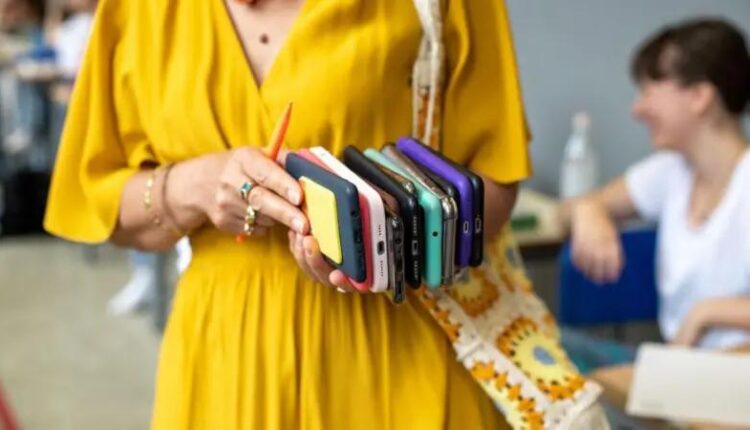As a middle-school teacher, Nancy Streit understands how hard it can be to compete with a smartphone for a child’s attention.
But as a mother, she knows the devices are a necessity when there’s an emergency.
“It’s mostly the parents calling,” she says, adding that while she doesn’t allow phone use in her classroom, students routinely skirt the rules.
The Los Angeles school district where Ms Streit teaches – the second largest school district in the country – is the latest to ban smartphone use in schools this week.
It is part of a growing and familiar trend as more states and schools across the US weigh how to manage the growing dependency children have on their devices.
New York and California, two of the most populous US states, are weighing new state-wide policies on the issue.
Earlier this week, California Governor Gavin Newsom called for a ban on smartphones in classrooms and said he would work with legislators on a policy.
In New York, Governor Kathy Hochul has advocated for a similar law.
This spring, Indiana’s governor signed into law a classroom ban, set to begin in the autumn.
The efforts mark the latest chapter in a long debate over policing smartphone use in schools, and comes amid a wave of concern about youth mental health in the aftermath of the pandemic.
Most US schools already have some kind of phone policy. About 76% of schools prohibited their non-academic use in the 2021-2022 school year, according to the US Department of Education.
The latest wave of regulations, however, seeks to take that further.
Raphaela Hodges, a grade six teacher at a Los Angeles school, says she has seen a concerning and dramatic change in how children socialise.
“When they’re uncomfortable they pick up the phone,” she told the BBC.
It is also an issue with rare bipartisan consensus, with legislators in Republican and Democratic-controlled states alike pursuing similar policies.
Florida implemented a state law last year that required school districts to bar phones from classrooms and block access to social media on school wi-fi.
The law also requires schools to “provide instruction on the social, emotional, and physical effects of social media”.
Individual districts in states including Maine and Virginia are also instituting stronger rules surrounding phone use, as are provinces in Canada including Ontario and Alberta.
An enduring debate
Concern surrounding phones in schools has existed for almost as long as the devices have been around, with little consensus and much controversy.
The US has seen several attempts to ban communication devices from classrooms since the 1980s.
Early critics feared the potential of phones to distract students and their association with the drug trade.
But the 1999 shooting at Colorado’s Columbine High School, in which 13 people died, led some parents and schools to reassess phones as a key communication tool for emergencies. States relaxed the rules – including California, which repealed a phone ban in 2002.
The debate was reignited as schools saw phones as a growing distraction, an aid to cyberbullying and a potential means for students to cheat on assignments.
The city of New York, which has a total of more than one million students, began enforcing a strict ban – but reversed course in 2015 to allow individual schools to set policies.
Social media use and student mental health
The current wave of policies comes as experts express concern about student mental health and social media use.
On Monday, one of America’s most senior health officials called for warning labels akin to those on boxes of cigarettes on social media platforms.
Surgeon General Vivek Murthy argued that social media increased the risk that children would experience symptoms of anxiety and depression, though research on the topic has been mixed.
“You’ve got a situation where kids are not only trying to learn, but they’re simultaneously on their phones, they’re texting their friends, they’re replying to messages on social media, they’re scrolling through their feeds,” Dr Murthy told the BBC.
“It makes it very difficult not only to learn, but it makes it hard in school to build relationships and friendships.”
Adolescents who spend more than three hours a day on social media face double the risk of mental health problems, such as anxiety and depression, a study published in 2019 and frequently cited by federal health offices found.
Will the policy shift stick? Schools have historically struggled to find a balance between safety and limiting the siren call of social media.
Ken Trump, the president of the National School Safety and Security Services, said that policies would not work without strong community consensus and consistency in enforcement.
“There’s a lot more to it than the average parents or other person looking from afar would think. It’s a wicked problem, there are a lot of complexities to it,” said Mr Trump.
In Los Angeles, board members voted on Tuesday to ban the devices from next year. But how the policy will work is still not clear.
Alyssa, an 18-year-old from Los Angeles where many schools have thousands of pupils, told the BBC she could not imagine being in high school without a phone.
“We have huge campuses – no one can monitor all that,” she said. “There are tons of areas where you can go and not be seen.”
Source: BBC


Comments are closed.